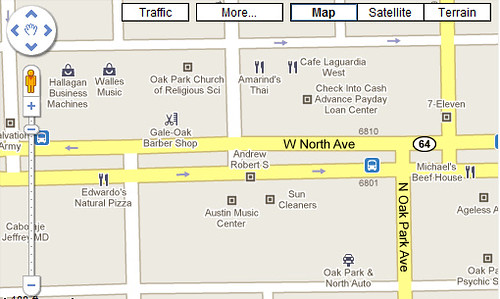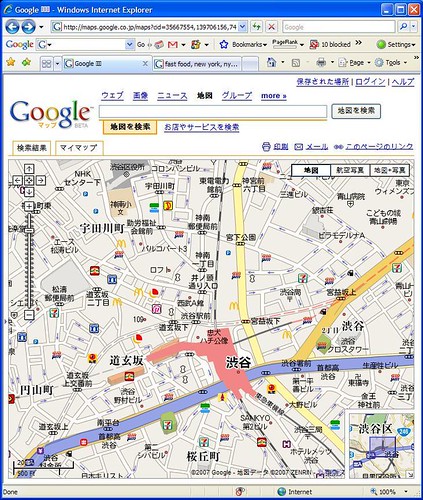Can Your Business Achieve Landmark Status In Google Maps?
In August of this year, Google quietly began incorporating small, clickable areas within Maps, for parks, landmarks — and yes, even some businesses. These clickable "landmark icons" appear for any kinds of searches, even simple address searches. For a business, what does it take to achieve "landmark" status?
In August Google quietly began incorporating small, clickable areas within maps, for parks, landmarks—and yes, even some businesses. These clickable “landmark icons” appear for any kinds of searches, even simple address searches. For a business, what does it take to achieve “landmark” status?
Online mapping providers have long offered add-on features beyond the basics of streets, cities and address pinpointing. Additional features have included things like county boundary lines, lakes, rivers, creeks, parks, major local landmarks and historical or cultural places.
When you think about it, inclusion of distinctive natural features and landmarks makes a lot of sense in maps. Not only are they things which people may frequently try to find, but landmarks by their nature also help people to further orient themselves when trying to give directions or recognize where they are in relation to the environment.
Example of Landmark Business Icons in Google Maps—location in Oak Park, IL
However, treatment of businesses as iconic map landmarks is a bit unusual, and it doesn’t take long for people to recognize that any business which shows up on a mapped area for all kinds of searches will be getting a lot more exposure and promotional benefit. These businesses will appear every time users are browsing maps in that area, and they could get more clickthroughs and conversions than the rest of the businesses which must be specifically invoked through name/category/keyword searches for which they’re relevant.
Displaying some business locations by default has actually been going on in online maps for quite some time. Mapquest and others have been doing this in various ways for years. Google’s actually been experimenting with this for some time, as shown by this map of Tokyo, Japan, generously sprinkled with colorful business icons for McDonald’s, 7-Elevens, and other businesses (though, the landmark business icons on the Tokyo map are not clickable):
It appears that Google Maps is doing this in an effort to make the maps more useful, and to expose more of their content to users for discovery as they browse around areas. While we’re all trained to think that Google must have commercial reasons for virtually every new feature we see, there’s obviously some altruistic navigational benefit to having some businesses exposed on maps all the time—businesses themselves really are landmarks and can be every bit as useful as other landmarks when people are navigating through unfamiliar environments.
Google has developed teeny-tiny icons to specifically symbolize a few types of businesses, including coffee cups for coffee shops, knife-and-forks for restaurants, car icons for automotive shops, a purse or shopping bag or shopping cart for retail outlets, dollar signs for banks, graduation caps for colleges, beds for accommodations, martini glasses for bars, envelopes for postal stores, kids for schools, white crosses on briefcases or crossed signs or mortal-and-pestles for medical offices and drug stores—and many more.
These icons are linked and when clicked open a traditional info-bubble over a map, containing a business’s street address, website and phone number. Clicking on the “more info” link takes you to the businesses “place page“.
This iterative evolution of the map interface raises the inevitable question for all local businesses: What can I do to achieve landmark status in my local area maps?
From my exploration of the businesses which are showing up by default in maps, I believe there’s very little that a business can do to influence their chances of hitting landmark status. I perceive a complex mixture of a few different elements which define if and when a business may get the landmark icon treatment, and most of this is stuff that a business cannot do much to alter.
Some factors which appear to influence landmark status:
Business category. Entertainment businesses, hotels and restaurants appear to be more likely to be displayed. Other business categories have a chance as well, but where there’s little room available, the entertainment-hotels-restaurants types of businesses are going to get first crack at appearing, edging out other types of neighboring businesses.
Zoom level/business density. It stands to reason that one can’t always display all businesses that may live at a particular location, or else the map would be rendered illegible. Therefore, you’re more likely to appear if you’re located in a slightly less-dense location. Shopping malls and tower office buildings will have many businesses competing for room on the mapped display, so some businesses will not get the marquee status.
This density limitation combines with category—if you’re an automotive shop squeezed between a hotel and a restaurant, their names will be displayed on the map first, and there won’t be room left to display yours. Further, Google appears to have set a limit on how many businesses may be displayed by default in an area and according to zoom level, since they don’t display all business names, even when there may be room to do so. They want to keep some happy medium in map legibility, so they appear to have set limits to keep the interface from appearing too busy.
Years in business. It’s not entirely clear, but it may be that a business with greater seniority could be preferred above newer businesses. This would make some sense, because a business that’s been around longer will be more likely to be well-known and more likely to be used as a navigational reference point. If true, age of business is only has a weak influence, I believe. In my exploration of landmark icons, I’ve found a number of cases where newer businesses in the entertainment/restaurant/hotel categories were displayed before some older businesses in the same area.
Authoritativeness/popularity. A number of other factors may be feeding in by some degree as well, particularly factors which we’ve identified before as being useful to Google in gauging relative importance and popularity between business. These factors could include PageRank, numbers of citations, the quantity, quality and velocity of reviews and ratings, and more.
Related Wikipedia page. Quite a few landmarks are associated with their Wikipedia pages within Google Maps, so if your business is notable enough to merit inclusion in Wikipedia, then you may have more of a chance of getting landmark treatment. If you think this is a stretch, the Google LatLong blog even mentions linkage to the Wikipedia articles in its post announcing the landmark icon treatment. Take note, however! Wikipedia has moderately strict guidelines for whether a subject is sufficiently “notable” or not to be included in the online encyclopedia, so do not add an article about yourself or your business willy-nilly to the site—instead, ask a well-experienced Wikipedian if they would consider adding an article about you.
In short, there’s little a business can do to achieve landmark icon status within Google Maps, other than to follow the local search best-practices that many of us have outlined for achieving best chance for rankings within local results. If you have not done so already, be sure to claim your business within Google’s Local Business Center (LBC), and be sure to add appropriate business category names for yourself (stands to reason that a business not properly identified as a restaurant/hotel/entertainment business could rapidly achieve landmark icon status merely by inputting their category in the LBC). Also, be sure those category names are reflected on your website, and list your years in business on your “about” page or homepage.
I expect that Google will likely continue to experiment with the visual display of landmark information, and they’ll likely further test relative densities of content they display to see what’s optimal from a user-experience standpoint. So stay tuned for more changes as Google Maps evolves, and continue incorporating best practices in your local search marketing.
If you have achieved “landmark icon status” for your business in Google Maps, you can give yourself a small pat on the back. It’s a good indicator that Google’s algorithms consider you to be a “prominent business,” and your online profile shows you to be advantageously authoritative.
Contributing authors are invited to create content for Search Engine Land and are chosen for their expertise and contribution to the search community. Our contributors work under the oversight of the editorial staff and contributions are checked for quality and relevance to our readers. The opinions they express are their own.
Related stories

